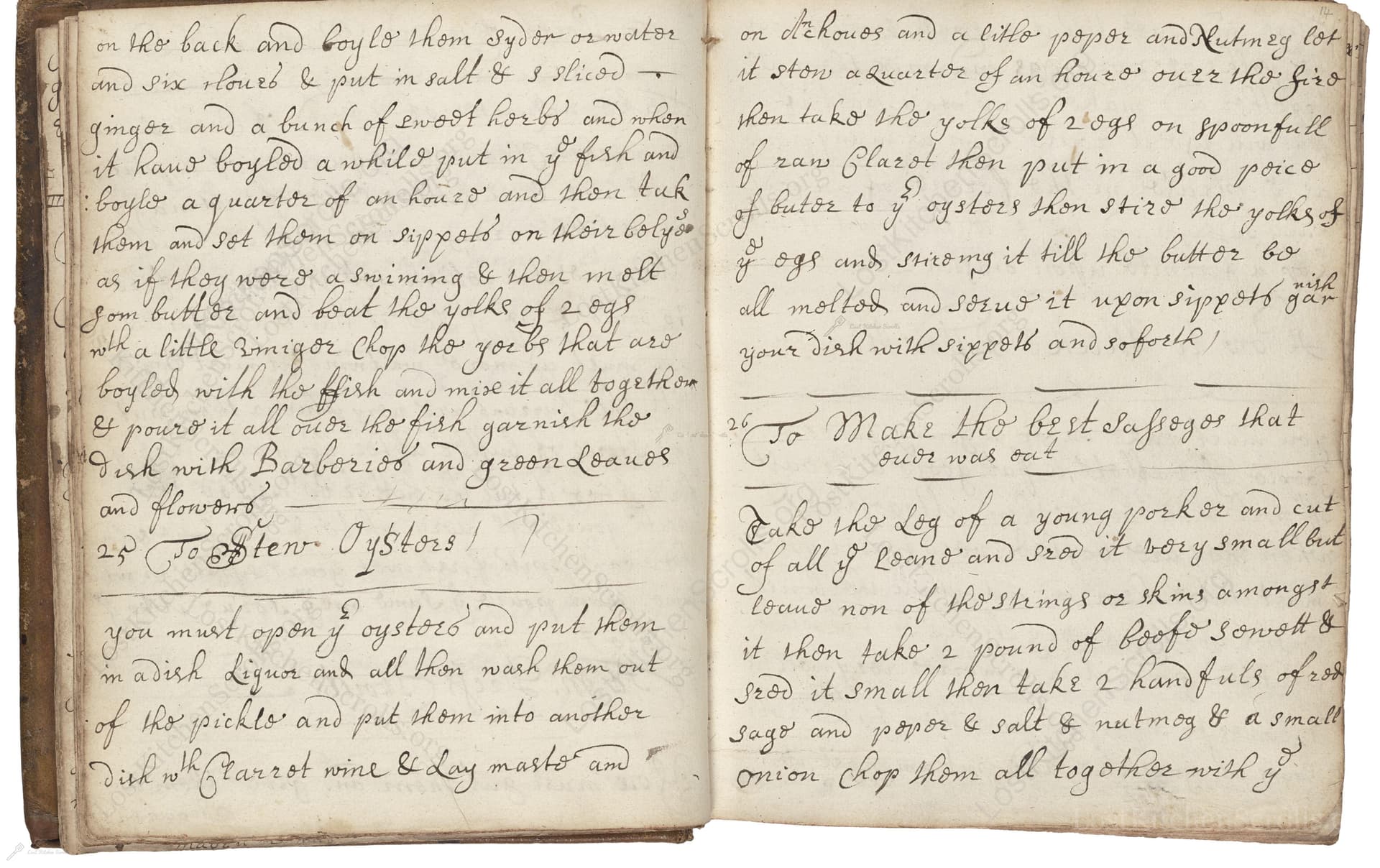To Stew Oysters
From the treasured pages of Cookbook of Elizabeth Fowler
Written by Elizabeth Fowler

To Stew Oysters
"you must open ye oysters and put them in a dish Liquor and all then wash them out of the pickle and put them into another Dish wth Clarret wine & Lay mace and on Anchoues and a little peper and Nutmeg let it stew a Quarter of an Houer ouer the fire then take the yolks of 2 egs on spoonfull of raw Claret then put in a good peice of butterr to ye oysters then stire the yolks of ye egs and wine ney it till the butterr be all molted and serue it upon sippets gar your dish with sippets and soforth /"
Note on the Original Text
Recipes of this era are written without standard measures or step-by-step timing—they assume the cook's prior knowledge and intuition. Spelling is fluid ('Clarret' for claret, 'Anchoues' for anchovies, 'serue' for serve), and punctuation is sparse. The directions flow as a single sentence, reflecting the spoken transmission of recipes. The term 'pickel' here refers to the briny liquor or storage liquid from the oysters, and 'sippets' are simply small pieces or fingers of toasted bread. Instructions for thickening with egg yolks and butter hint at an early awareness of sauce-making techniques, even before the modern French culinary lexicon.

Title
Cookbook of Elizabeth Fowler (1684)
You can also click the book image above to peruse the original tome
Writer
Elizabeth Fowler
Era
1684
Publisher
Unknown
Background
A charming window into the kitchens of 17th-century England, this cookbook authored by the accomplished Elizabeth Fowler invites you to explore a delectable world of historic recipes, tempting sweets, and elegant table fare fit for any refined palate.
Kindly made available by
Folger Shakespeare Library
This recipe hails from Elizabeth Fowler's personal collection, dated 1684. England in the late seventeenth century was a place of culinary experiment and borrowed luxury, with oysters plentiful and widely enjoyed across classes. Claret wine and spices like mace and nutmeg were expensive imports, signaling status in recipes such as this. Serving oysters stewed with wine and spices over sippets (toasted bread) was a mark of a refined, cosmopolitan kitchen. Manuscript cookbooks like Fowler's were often treasured and handed down, written in a flowing hand by women documenting both humble fare and elaborate showpieces fit for an upper-class household.

Cooks would have used an oyster knife for shucking, shallow brass or iron pans for stewing, a hearth or open fire as the heat source, and sturdy wooden spoons or whisks for stirring. For the final garnish, sippets were made by slicing and toasting bread before placing it artfully on serving platters. Simple ceramic or pewter dishes would have held the finished dish, which was likely brought straight from the kitchen to the manor table.
Prep Time
10 mins
Cook Time
15 mins
Servings
4
We've done our best to adapt this historical recipe for modern kitchens, but some details may still need refinement. We warmly welcome feedback from fellow cooks and culinary historians — your insights support the entire community!
Ingredients
- 14 oz fresh oysters, shucked, with liquor reserved
- 1/2 cup dry red wine (Claret/Bordeaux style)
- 1–2 mace blades (or a pinch of ground mace if unavailable)
- 2 anchovy fillets (salted or oil-packed, finely chopped)
- Pinch of ground black pepper
- Pinch of grated nutmeg
- 2 large egg yolks
- 1 tbsp red wine (raw, for egg mixture)
- 2 tbsp unsalted butter
- 4-6 slices white bread (for sippets), lightly toasted
Instructions
- Begin by shucking about 14 ounces of fresh oysters, reserving their liquor (the liquid inside the shells).
- Give the oysters a rinse in their own liquor, then transfer them to a shallow pan or baking dish with about 1/2 cup of dry red wine (use a modern claret or Bordeaux-style wine for authenticity).
- Add 1 or 2 whole mace blades, 2 finely chopped anchovy fillets, a pinch of freshly ground black pepper, and a pinch of grated nutmeg.
- Gently stew this mixture over low heat for about 15 minutes.
- In a small bowl, whisk together 2 large egg yolks and 1 tablespoon of raw red wine.
- Add a generous knob of unsalted butter (about 2 tablespoons) to the oysters, stirring gently as it melts.
- While the mixture is still hot but not boiling, stir in the yolk-and-wine mixture, whisking continuously to thicken slightly (but not scrambling the eggs).
- Serve the oysters and their sauce over lightly toasted bread sippets (small pieces or fingers of bread), garnishing the dish with extra sippets around the edges.
- Serve right away while still warm.
Estimated Calories
180 per serving
Cooking Estimates
It usually takes about 10 minutes to prepare the oysters and other ingredients, and about 15 minutes to cook everything gently on the stove. Each serving has around 180 calories. This recipe makes 4 servings.
As noted above, we have made our best effort to translate and adapt this historical recipe for modern kitchens, taking into account ingredients nowadays, cooking techniques, measurements, and so on. However, historical recipes often contain assumptions that require interpretation.
We'd love for anyone to help improve these adaptations. Community contributions are highly welcome. If you have suggestions, corrections, or cooking tips based on your experience with this recipe, please share them below.
Join the Discussion
Rate This Recipe

Den Bockfisch In Einer Fleisch Suppen Zu Kochen
This recipe hails from a German manuscript cookbook compiled in 1696, a time whe...

Die Grieß Nudlen Zumachen
This recipe comes from a rather mysterious manuscript cookbook, penned anonymous...

Ein Boudain
This recipe comes from an anonymous German-language manuscript cookbook from 169...

Ein Gesaltzen Citroni
This recipe, dating from 1696, comes from an extensive anonymous German cookbook...
Browse our complete collection of time-honored recipes



